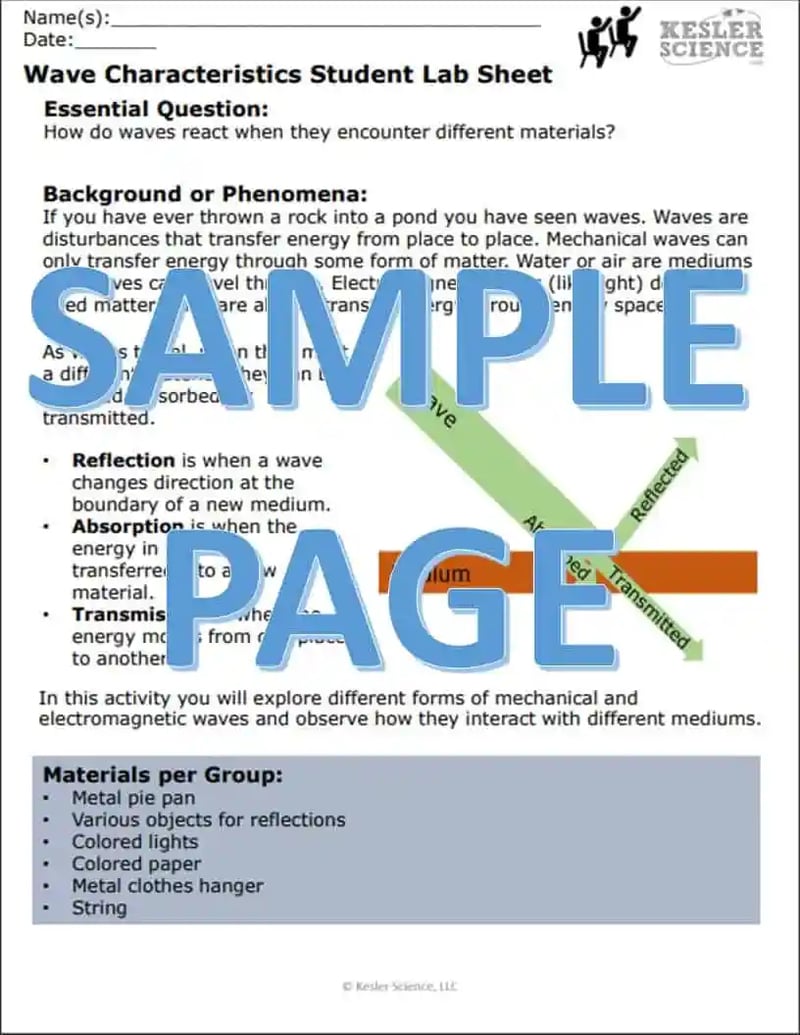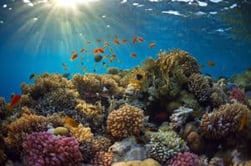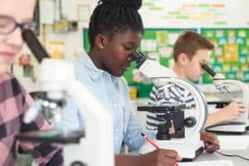Wave Characteristics Inquiry Lab
Middle School Inquiry Lab on Wave Characteristics
In this lab students will observe how matter and energy waves change based on their interaction with various materials.
Each inquiry lab will contain an essential question that will drive the lesson and make students think. For this lesson, the essential question is:
- How do waves react when they encounter different materials?
BACKGROUND INFORMATION AND MATERIALS LIST:
Students will begin the lab by reading the essential question and background information. This can be done individually, as lab groups, or as a whole class. If you consider lab groups, you also might include some type of whole class formative checks before digging into the lab.

Materials List:
- metal pie pan
- various objects for reflections
- colored lights
- colored paper
- metal clothes hanger
- string

PROCEDURE:
For this lab, you will have to set up three different sections for students to complete. For the first part, reflection, students will have to crate waves in a pie pan with water and observe how the waves react as they hit certain objects. Students will place different objects in the pan and watch how the waves react when they reach the boundary of the object. Students will record what they see the water do on their lab sheet.
For the next part, absorption, students will take three different colored lights and shine them on four different sheets of paper. Students will have to record how the lights shined against paper of the same color and paper of a different color.
For the last part, transmission, students will see how sound travels from a wire hanger striking three different objects. Students will tie string around their fingers and hanger. As they strike the object, students will listen to the sound it makes. Students will strike the same object again, only this time with their fingers in their ears. Students will record both sounds, no fingers in ears and with fingers in ears, on their lab sheet.
CHECK FOR UNDERSTANDING:
At this point in the lab, students will be checked for understanding by answering questions about their findings. Here are a few that come with the lab:
- What happens to the water wave at solid boundaries?
- Is a water wave a mechanical or electromagnetic wave? How can you tell?
- What happens when the light and paper are the same color?
- What happens when the light and the paper are a different color?
- Why do the sound waves seem different when your fingers are in your ears?
- What kind of waves are sound waves if they require matter for their transmission?
CONCLUSION
Students will go back to the essential question and write a CER (Claim, Evidence, Reasoning) to conclude the lab. Once completed, students will reflect back on their learning by answering the following questions:
- Describe an everyday example of transmission, absorption, or reflection of waves.
- Describe another experiment you could do to show how waves are transmitted, absorbed, or reflected through a medium.
MODIFIED AND INDEPENDENT INQUIRY VERSIONS
All of the Kesler Science inquiry labs come with three different modification levels. Each lab is differentiated using the icons below.
STANDARDS ALIGNMENT
NGSS: MS-PS4-2 – Develop and use a model to describe that waves are reflected, absorbed, or transmitted through various materials.

Download Over $100 in FREE Resources
For Middle School Science
Simply create a login below and gain immediate access to a selection of our Kesler Science product line worth $100 - for FREE. There's a full version of every product type! You'll also join tens of thousands of middle school science teachers who receive timely tips and strategies straight to their inbox.





